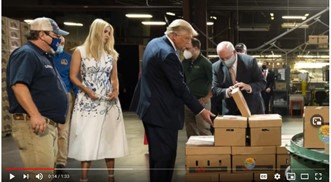U.S. Secretary of Agriculture Sonny Perdue today applauded the accomplishments made by the U.S. Department of Agriculture (USDA) over the past year.
“While this was a tough year with the coronavirus, historic wildfires, and weather damage, USDA met these challenges with a multitude of programs and services to support Americans and keep our agricultural sector running and responsive to the country’s needs,” said Secretary Perdue. “We salute our mission areas and agencies for keeping our customers front and center, serving the American people, farmers, ranchers, foresters, and producers.”
Farmers to Families Food Box Program:
USDA’s Agricultural Marketing Service (AMS) purchased $8.6 billion in food for delivery to food banks, churches, schools, community organizations, tribal organizations, and international food aid organizations through various programs during Fiscal Year 2020. Using Coronavirus Food Assistance Program (CFAP) funding, USDA announced the
Farmers to Families Food Box Program on April 17, 2020. Through this program, USDA has been partnering with national, regional and local distributors, whose workforces have been significantly impacted by the closure of restaurants, hotels and other food service businesses, to purchase up to $4.5 billion in fresh fruits and vegetables, dairy products and meat products from American producers of all sizes. Distributors then package these products into family-sized boxes and transport them to food banks, community and faith-based organizations, and other nonprofits serving Americans in need.
The Food Box Program has provided more than 125 million food boxes to Americans in need and will purchase nearly $4.5 billion worth of food by the end of the year.

(You may view the
Farmers to Families Food Box Program video or click on the image above to watch a highlight video of USDA’s Farmers to Families Food Box Program in action across the United States)
Coronavirus Food Assistance Program (CFAP) Funding:
Working with the Office of the Chief Economist (OCE), the Office of the General Counsel (OGC), and the Agricultural Marketing Service (AMS); FSA and the Farm Production and Conservation Business Center quickly built and delivered two rounds of the
CFAP, which provides financial assistance to help producers absorb some of the revenue losses and increased marketing costs associated with the COVID-19 pandemic. So far, CFAP 1 and CFAP 2 made available $30 billion in relief. Additionally, USDA’s Farm Service Agency (FSA) and Natural Resources Conservation Service (NRCS) worked together to adopt new processes for electronic signatures to ensure producer and field staff could use electronic tools safely and securely.
(You may view the
CFAP video or click on the image above to learn about the program)
Ensuring Access to Food:
USDA’s Food and Nutrition Service (FNS) took unprecedented steps to ensure that children and low-income individuals had access to nutritious food in response to the pandemic as well. FNS issued more than 4,000 program flexibilities to adjust to local needs and maximize access for all eligible families across each of USDA’s 15 nutrition assistance programs. In October, USDA announced it would allow free meals to continue to be available to all children throughout the entire 2020-2021 school year. This unprecedented move is part of USDA’s unwavering commitment to ensuring all children across America have access to nutritious food as the nation recovers from the COVID-19 pandemic.
Trade:
In January, the United States and China reached a historic agreement on a
Phase One trade deal that set forth structural and technical reforms to China’s trade practices in the areas of intellectual property, technology transfer, agriculture, financial services, and currency and foreign exchange. The Phase One agreement addressed many non-tariff barriers to U.S. agriculture; it also included a commitment by China to make substantial purchases of U.S. goods and services. This agreement led to a record pace of Chinese purchases in many sectors, boosting agricultural commodity prices. In July,
The United States-Mexico-Canada Agreement (USMCA) entered into force, replacing the decades-old NAFTA, expanding market access for U.S. farmers to sell their products to our closest neighbors. In ongoing engagements with
the European Union, and as the U.S. pursues a post-Brexit free trade agreement with the United Kingdom, Secretary Perdue and USDA called for transparent, science-based trade policies that foster innovation and ensure that agriculture remains economically, environmentally and socially sustainable.